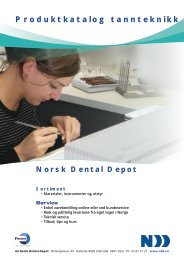Biodentine
Biodentine
Biodentine
You also want an ePaper? Increase the reach of your titles
YUMPU automatically turns print PDFs into web optimized ePapers that Google loves.
6<br />
1.1 - Setting reaction<br />
The calcium silicate has the ability to interact with water leading to the setting and<br />
hardening of the cement. This is a hydration of the tricalcium silicate (3CaO.SiO2 = C3S)<br />
which produces a hydrated calcium silicate gel (CSH gel) and calcium hydroxide (Ca (OH)2).<br />
2(3CaO.SiO2) + 6H2O 3CaO.2SiO2.3H2O + 3Ca(OH) 2<br />
C3S CSH<br />
This dissolution process occurs at the surface of each grain of calcium silicate. The<br />
hydrated calcium silicate gel and the excess of calcium hydroxide tend to precipitate at<br />
the surface of the particles and in the pores of the powder, due to saturation of the<br />
medium. This precipitation process is reinforced in systems with low water content.<br />
CSH<br />
CaOH<br />
2- H SiO 2 4<br />
Ca2+ O H 2<br />
<strong>Biodentine</strong> Particle<br />
H 2 O<br />
The unreacted tricalcium silicate grains are surrounded by layers of calcium silicate<br />
hydrated gel, which are relatively impermeable to water, thereby slowing down the effects<br />
of further reactions. The C-S-H gel formation is due to the permanent hydration of the<br />
tricalcium silicate, which gradually fills in the spaces between the tricalcium silicate<br />
grains. The hardening process results from of the formation of crystals that are deposited<br />
in a supersaturated solution.<br />
Powder before hydration Deposition of CSH <strong>Biodentine</strong> after setting















